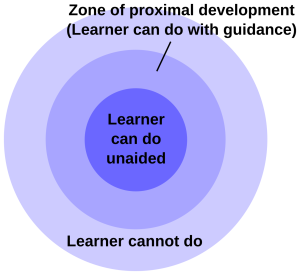Collaborative Learning Theory
Tani Sapp
Learning Objectives
By the end of this chapter you will be able to…
- Define Collaborative Learning
- Identify Fundamental Tenants of Collaborative Learning
- Identify Strengths and Limitations of the Theory
Introduction to Collaborative Learning Theory
Collaborative Learning Theory is a process in which a group (or groups) of students learn from each other by working together to solve a problem, complete a task, create a product, or share their thinking. The following video gives a quick overview of Collaborative Learning.
This theory is rooted in the work of Lev Vygotsky’s (1934) social development theory and Zone of Proximal Development (ZPD), which highlighted the importance of communication and social interaction in learning. The ZPD is the gap between what a learner can do independently and what they can achieve with guidance and support. In collaborative learning, students bridge this gap by sharing knowledge, questioning each other, and co-constructing understanding. Vygotsky suggested that learning happens with the support of a More Knowledgeable Other (MKO), and in collaborative learning, peers take on this role by explaining concepts, challenging ideas, and providing scaffolding through discussion. While there is no one originator, the work of Vygotsky has provided the foundation for the emergence of collaborative learning.

Collaborative Learning Theory promotes active learning techniques. It supports inquiry and knowledge creation and stimulates higher levels of cognitive processing, which are essential for twenty-first-century learning needs. Collaborative learning is an increasingly valued teaching and learning practice in education. Ideally, during collaborative inquiry, learners monitor their understanding collaboratively to discover gaps in their knowledge base and actively implement appropriate study tactics and resources to overcome these gaps in coordination between the group members.
Origins of the Collaborative Learning
Collaborative learning is rooted in Vygotsky’s Zone of Proximal Development. Vygotsky emphasized that learning occurs through social interactions rather than in isolation, paving the way for group learning approaches like collaborative learning. This perspective underscores the importance of communication, shared problem-solving, and collective meaning-making in education.
Collaborative learning is often confused with cooperative learning. Both cooperative and collaborative learning differ from the traditional teaching and learning methods, as both models have students working together in a group or team environment to complete a task. Collaborative learning is group-structured, as the students organize and divide the work between themselves. Each student is responsible for his/her work separately, but is also in charge of the team’s work as a whole. Think-Pair-Share or Write-Pair-Share is an example of collaborative learning where students are given a discussion prompt, question, short problem, or issue to consider. Individuals work briefly on the response, share with a partner, and then to the larger group.
Cooperative learning, on the other hand, is a structured approach in which the teacher is directly involved in the learning process. The teacher holds each member of the group accountable for a specific task, and it is the responsibility of this individual to help others learn that task. An example of a cooperative learning activity would be the teacher using a Jigsaw strategy, whereby each student is required to research one section of the material and then teach it to the other group members.

In the following example, you will see three different lessons that address the same objective. Take note of how the lesson changes based on the teaching approach, even though the objective remains the same.
4th Grade ELA Lesson: Collaborative vs. Cooperative vs. Traditional Approaches
Objective:
Students will analyze a short story’s character development and write an alternate ending.
Collaborative Learning Approach
Introduction: This approach encourages students to work together as equal contributors, allowing for organic discussions and shared meaning-making.
- Students work together as equals in small groups with no assigned roles.
- They discuss and negotiate their ideas organically to determine the character’s changes, emotions, and motivations in the story.
- Using a shared document (Google Docs/Padlet), they highlight key details and co-construct meaning through peer discussion.
- For the writing task, the group collectively brainstorms ideas, revises, and writes an alternate ending or new scene by contributing freely.
- The teacher guides discussions by posing thought-provoking questions but does not assign specific roles.
Key Features: Equal participation, open-ended discussions, and peer-driven knowledge construction.
Cooperative Learning Approach
Introduction: This structured approach ensures that students collaborate effectively by assigning roles and responsibilities to maintain accountability.
- Students work in small groups but with assigned roles (e.g., Discussion Leader, Recorder, Timekeeper, Writer).
- Each student has a specific responsibility, ensuring accountability in analyzing character development.
- Groups read the text, complete a structured worksheet with key character questions, and present findings to the class.
- For the writing task, students follow a structured plan, where each role contributes (e.g., one writes, one edits, one adds dialogue).
- The teacher monitors and facilitates by ensuring each student stays within their assigned role.
Key Features: Defined roles, structured collaboration, teacher-directed oversight.
Traditional Learning Approach
Introduction: This method follows a teacher-centered approach where students work individually on projects.
- The teacher leads a whole-class discussion, asking students to analyze the story’s characters.
- Students answer comprehension questions independently, writing responses in a worksheet.
- The teacher provides a writing guide, and each student writes their own alternate ending.
- Peer interaction is minimal—students may share their work aloud, but feedback is not required.
Key Features: Teacher-centered, individual work and individual assessment.
Fundamental Tenets of the Theory
A few key guiding principles drive the implementation of cooperative learning in the classroom.
-
Utilizing Informal and Formal Collaborative Learning Groups
- Informal collaborative learning groups consist of smaller clusters of students assigned to work together, temporarily (usually one class period), on a specific task for a short period. An example of this type of collaborative learning would occur in groups of 3-5 students working on the solution to a problem-solving question. A smaller group helps to keep all students on-task, enabling everyone to participate and share their ideas with the solution, i.e., smaller breakout groups in an online course. With formal learning groups, learners are arranged into specific teams and must work together for more extended periods on an extensive project(s). An example of this type occurs when an instructor defines the activity’s learning objects and success criteria and assigns the student groups with specific tasks. The instructor continues to monitor the work and evaluates group and individual performance.
-
Applying Problem-based Learning (PBL)
- Problem-based learning is where a particular problem is introduced for students to solve, often in groups, over a given period. Sometimes, the group may only be given the topic and must develop the problem to solve. It is required that students ultimately understand the problem before proposing a solution or response. The PBL method can be incorporated effectively into a post-secondary biology class to engage students in solving authentic biological case studies to reinforce learning. This process begins with the instructor forming small groups and presenting the problem statement. Each group works collaboratively with its members to brainstorm ideas/solutions to the problem and then shares their results with other groups (and the entire class) to come to a final solution, through consensus.
-
Providing Assessment Through Feedback and Reflection
- Collaborative learning is enhanced through assessment as it encourages students to take responsibility for their participation in teamwork and helps them understand the nature of collaboration as opposed to competition. Assessment is vital to evaluate group productivity and how well individuals work together as effective members within a group. Grading of individuals can be accomplished through individual contributions and the use of self, peer, and group assessment, feedback, and reflection. Examples of individual and group contributions may include tests or assignments, rubrics, performance-based assessments, participation, media works, and/or anonymous feedback.
Strengths and Limitations of the Cooperative Learning Theory
Compared to individual learning, collaborative learning allows students to discuss and have a higher level of thinking, and retain information for longer. In the collaborative learning environment, regardless of the level of learning achievement, students generally perform better than their peers who study alone. In the process of collaborative learning, students’ communication with each other is also considered helpful. Collaborative learning can improve learning more effectively and reinforce students’ satisfaction with the entire learning process.
While there are many benefits of a collaborative learning classroom, this model has some implementation barriers. Challenges include dependence on others for solutions, the lack of time in the curriculum, and students’ lack of skills to cooperate. The traditional model of education is expanding into virtual spaces. The rise of asynchronous learning may make collaboration more difficult as students are not physically (or visually) in front of each other.
Instructional Design Implications
Collaborative learning theory uses social learning at the core. Designers need to emphasize discussion and cognitive adjustment through communication. Opportunities for discussion and group work will be key. Instructional strategies such as project-based learning or inquiry projects are well suited for collaborative learning. Using a driving question and a problem to solve, groups can work together to devise a creative solution to the given problem. Design should include activities that encourage peer-to-peer communication and collaboration. Designers should consider group projects, discussions, and peer feedback opportunities.
In collaborative learning, assessment needs to show individual responsibility for participation and group responsibility for the overall product. After presenting their work to the class, students can self-assess their roles in the project. These self-assessments aid in metacognition as students grow in the art of collaboration.
Conclusion
Collaborative learning has significant implications for educational practices, as it encourages student-centered problem solving and peer collaboration in the classroom. Emerging technologies such as video conferencing platforms, Artificial Intelligence, and virtual collaborative boards will allow collaborative learning to span time and space.
Collaborative learning requires interdependence to achieve a shared goal. This learning theory increases understanding, self-esteem, and responsibility. The basis of collaborative learning is learning with and from others. Learning often happens in the journey, not just the destination. How can we add collaboration to make sure we don’t miss the growth and discoveries along the way?
Review Collaborative Learning Theory below.
References
Cheng, F.-F., Wu, C.-S., & Su, P.-C. (2021). The impact of collaborative learning and personality on satisfaction in innovative teaching context. Frontiers in Psychology, 12, 713497. https://doi.org/10.3389/fpsyg.2021.713497
Contributors to Wikipedia projects. (2024). Collaborative learning. Wikipedia. https://en.wikipedia.org/wiki/Collaborative_learning
Ibrahim, K. A. A.-A., Carbajal, N. C., Zuta, M. E. C., & Bayat, S. (2023). Collaborative learning, scaffolding-based instruction, and self-assessment: Impacts on intermediate EFL learners’ reading comprehension, motivation, and anxiety. Language Testing in Asia, 13(1), 1–33. https://doi.org/10.1186/s40468-023-00229-1
Järvenoja, H., Malmberg, J., Törmänen, T., Mänty, K., Haataja, E., Ahola, S., & Järvelä, S. (2020). A collaborative learning design for promoting and analyzing adaptive motivation and emotion regulation in the science classroom. Frontiers in Education, 5, 111. https://doi.org/10.3389/feduc.2020.00111
Keramati, M. R., & Gillies, R. M. (2021). Advantages and challenges of cooperative learning in two different cultures. Education Sciences, 12(1), Article 3. https://doi.org/10.3390/educsci12010003
Lew, G. (2020). Collaborative learning theory. Power Learning Solutions. https://pressbooks.pub/elearning2020/chapter/collaborative-learning-theory/
“Collaborative Learning Theory” by Tani Sapp is adapted from the following under a CC BY 4.0 license.
- Collaborative Learning Theory. by G. Lew
- Collaborative Learning by Wikipedia Contributors
“Collaborative Learning Theory” is licensed under CC BY 4.0.
This work was primarily human-created. AI was used to make new content, such as text, images, analysis, and ideas. AI was prompted for its contributions, or AI assistance was enabled. AI-generated content was reviewed and approved. The following model(s) or application(s) were used: ChatGPT, Canva Magic Studio.
